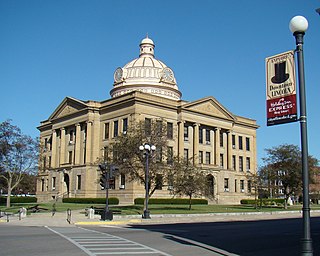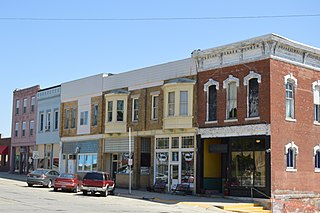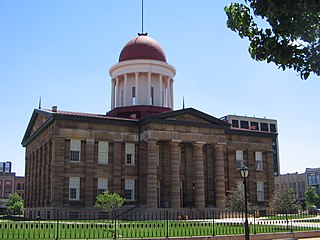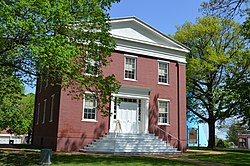
Lincoln is a city in Logan County, Illinois, United States. First settled in the 1830s, it is the only town in the United States that was named for Abraham Lincoln before he became president; he practiced law there from 1847 to 1859. Lincoln is home to two colleges and two prisons. The two colleges are Lincoln College and Lincoln Christian University. It is also the home of the world's largest covered wagon and numerous other historical sites along the Route 66 corridor.

Mount Pulaski is a city in Logan County, Illinois, United States. The population was 1,566 at the 2010 census, and 1,481 at a 2018 estimate. It is the home of the Mount Pulaski Courthouse State Historic Site. The city is named in honor of Polish Revolutionary War hero Casimir Pulaski. Mount Pulaski has one high school: Mount Pulaski High School, home of the Hilltoppers. The school colors are purple and gold. Mount Pulaski held the county seat of Logan County from 1848 to 1855.
The Illinois Historic Preservation Division, formerly Illinois Historic Preservation Agency, is a governmental agency of the U.S. state of Illinois, and is a division of the Illinois Department of Natural Resources. It is tasked with the duty of maintaining State-owned historic sites, and maximizing their educational and recreational value to visitors or on-line users. In addition, it manages the process for applications within the state for additions to the National Register of Historic Places.

The Old State Capitol State Historic Site, in Springfield, Illinois, is the fifth capitol building built for the U.S. state of Illinois. It was built in the Greek Revival style in 1837–1840, and served as the state house from 1840 to 1876. It is the site of candidacy announcements by Abraham Lincoln in 1858 and Barack Obama in 2007. It was designated a National Historic Landmark in 1961, primarily for its association with Lincoln and his political rival Stephen Douglas.

The Vandalia State House, built in 1836, is the fourth capitol building of the U.S. state of Illinois. It is also the oldest capitol building in Illinois to survive, as the first, second, and third capitol buildings have all disappeared. The brick Federal style state house has been operated by the state of Illinois as a monument of Illinois pioneer years since 1933. It is located in Vandalia, Illinois, on the National Road, and listed on the National Register of Historic Places.

The Lincoln Log Cabin State Historic Site is an 86-acre (0.3 km²) history park located eight miles (13 km) south of Charleston, Illinois, U.S., near the town of Lerna. The centerpiece is a replica of the log cabin built and occupied by Thomas Lincoln, father of U.S. President Abraham Lincoln. Abraham Lincoln never lived here and only occasionally visited, but he provided financial help to the household and, after Thomas died in 1851, Abraham owned and maintained the farm for his stepmother, Sarah Bush Lincoln. The farmstead is operated by the Illinois Historic Preservation Agency.

The Lincoln-Herndon Law Offices State Historic Site is a historic brick building built in 1841 in the U.S. state of Illinois. It is located at 6th and Adams Streets in Springfield, Illinois. The law office has been restored and is operated by the Illinois Historic Preservation Agency as a state historic site.
The Postville Courthouse State Historic Site is a replica county courthouse in Lincoln, Illinois, United States. The original frame courthouse was built in 1840 and later moved to Greenfield Village in Michigan; the current courthouse, which is a close replica of the first, was built in 1953. The building's unusual history is derived from its status as one of the courthouses used by lawyer Abraham Lincoln as he traveled the circuit of courtrooms in central Illinois. The courthouse replica is operated by the Illinois Historic Preservation Agency.

U.S. Route 66 was a United States Numbered Highway in Illinois that connected St. Louis, Missouri, and Chicago, Illinois. The historic Route 66, the Mother Road or Main Street of America, took long distance automobile travelers from Chicago to Southern California. The highway had previously been Illinois Route 4 (IL 4) and the road has now been largely replaced with Interstate 55 (I-55). Parts of the road still carry traffic and six separate portions of the roadbed have been listed on the National Register of Historic Places.

The Metamora Courthouse State Historic Site is a historic American courthouse located in Metamora, Illinois, the former county seat of Woodford County. The courthouse was built in 1845 as the governmental center for Woodford County and as a circuit court for the former Illinois Eighth Circuit. The courthouse is best known for being one of only two surviving Illinois circuit courthouses where future U.S. President Abraham Lincoln practiced law.

Lincoln is an Amtrak train station in Lincoln, Illinois, United States, at Broadway and Chicago Streets. Service is provided by Lincoln Service and the Texas Eagle. The current station is the rail line's former freight depot, renovated in 2017. Adjacent to the current station structure is a brick Spanish Mission-style depot building, constructed in 1911 by the former Chicago and Alton Railroad and later used by the Gulf, Mobile and Ohio Railroad. Although no longer used by Amtrak, the historic 1911 depot has been renovated for commercial use. During the 1980s and 1990s it served dually as a railroad station and restaurant.

The Ogle County Courthouse is a National Register of Historic Places listing in the Ogle County, Illinois, county seat of Oregon. The building stands on a public square in the city's downtown commercial district. The current structure was completed in 1891 and was preceded by two other buildings, one of which was destroyed by a group of outlaws. Following the destruction of the courthouse, the county was without a judicial building for a period during the 1840s. The Ogle County Courthouse was designed by Chicago architect George O. Garnsey in the Romanesque Revival style of architecture. The ridged roof is dominated by its wooden cupola which stands out at a distance.

The Nachusa House is a former hotel building in Dixon, Illinois, United States along Galena Avenue. The building was constructed in 1853 and operated continuously as a hotel until 1988. It underwent many alterations during the time it operated as a hotel. Following its period as a hotel the five-story mansard roofed building fell into disrepair and was nearly demolished in 1997. The building was restored by the Illinois Housing Development Authority and a Chicago developer at a cost of US$3.2 million and renovated into affordable housing for senior citizens. During its height the Nachusa House was a popular stop along rail and stagecoach lines and was a known layover for Abraham Lincoln. The Nachusa House was added to the U.S. National Register of Historic Places in 1983.

The Lincoln Courthouse Square Historic District is located in Lincoln, Illinois in Logan County. The district is roughly bounded by Sangamon, Pekin, Chicago, Delavan, Broadway, and Pulaski Streets. The district includes 112 buildings, 89 of which are contributing buildings.

Lincoln Depot is located in Springfield, Illinois. It is so called because Abraham Lincoln's bittersweet 1861 Farewell Address to Springfield was delivered here as he boarded the train to Washington D.C. at the beginning of his presidency.

The Abraham Lincoln National Heritage Area is a National Heritage Area in central Illinois telling the story of Abraham Lincoln. A National Heritage Area is a federal-designated area intended to encourage historic preservation and an appreciation of the history and heritage of the site. While National Heritage Areas are not federally owned or managed, the National Park Service provides an advisory role and some technical, planning and financial assistance.

McLevy Hall is a historic municipal building at 202 State Street in downtown Bridgeport, Connecticut. The building was built in 1854 to house both the City Hall and the Fairfield County Courthouse, and served as Bridgeport City Hall into the 1930s. It was renamed McLevy Hall after Bridgeport mayor Jasper McLevy in 1966. The current city hall on Lyon Terrace was built in 1916, however municipal offices continued to occupy McLevy Hall through the 1970s. It was added to the National Register of Historic Places on September 19, 1977.

The Pulaski County Courthouse is a government building in Mound City, the county seat of Pulaski County, Illinois, United States. Built in 1912 and damaged by the Great Flood of 1937, it remains in use as the county's courthouse.

The Alexander County Courthouse is a government building in central Cairo, the county seat of Alexander County, Illinois, United States. Built in the 1960s, it is the latest in a series of courthouses erected in four towns across Alexander County.


















